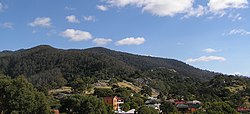Gulaga / Mount Dromedary
Template:WAP assignment



Mount Gulaga (formerly known as Mount Dromedary) is one of the highest mountains on the south coast of New South Wales, Australia. It rises above the village of Central Tilba and is within the Gulaga National Park. At its highest point it is 806 metres above sea level.[1]
Gulaga is the place of ancestral origin within the mythology of the Yuin people, the Indigenous Australians of the area. Gulaga itself symbolises the mother and provides a basis for Aboriginal spiritual identity, for Aboriginal women and men.[2] [3]
The first Europeans to sight the mountain were the crew of Captain Cook's ship, HMS Endeavour on 21 April 1770. Endeavour passed the mountain at a distance of 15 miles (24 km) offshore. Cook named it "Mount Dromedary" as its figure reminded him of the hump of a camel.[4]
References
- ^ "Mt Dromedary gold". Minerals. New South Wales Department of Primary Industries. 1997. Retrieved 2006-05-23.
- ^ Foster, Warren (2006). "Gulaga told by Warren Foster". Stories of the Dreaming. Australian Museum. Retrieved 2006-05-22.
{{cite web}}: Cite has empty unknown parameter:|coauthors=(help) - ^ NSW Minister for the Environment, Debus, Bob (2006). "Formal handback of Biamanga and Gulaga national parks to Aboriginal community: Media release - Friday, 3 February 2006". Media releases. Department of Environment and Climate Change. Retrieved 2006-05-22.
{{cite web}}: Cite has empty unknown parameter:|coauthors=(help) - ^ Beaglehole, J.C., ed. (1968). The Journals of Captain James Cook on His Voyages of Discovery, vol. I:The Voyage of the Endeavour 1768–1771. Cambridge University Press. p. 300. OCLC 223185477.
{{cite book}}: Cite has empty unknown parameters:|month=and|coauthors=(help)
36°18′00″S 150°01′30″E / 36.300°S 150.025°E




